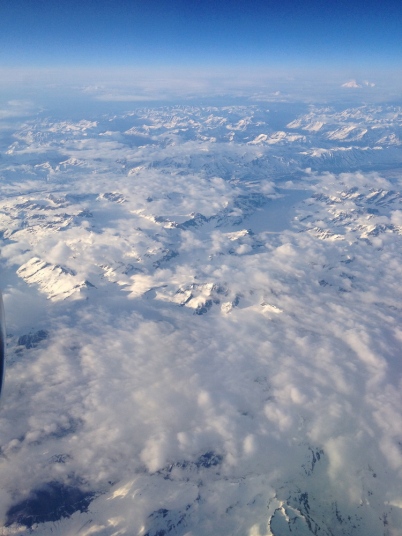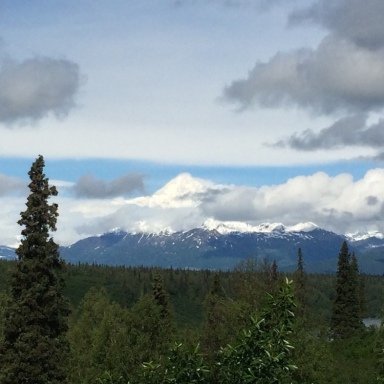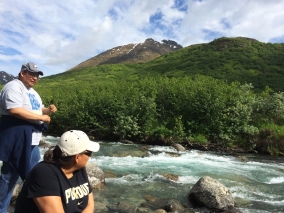June 23
We enter the interior by bus. At the edge of the wild, a bridge spans the Savage River – the same river we crossed on foot last night – and on the far side of the gully sits a ranger station guarding six million acres of Alaskan wilderness. Our bus leaves contrails of dust as we go off the paved highway and begin our rumble up the gravel road through the mountains.
Flowing sunlight
caught in streams of stone:
Savage River

In the Denali wilderness, we slip into a new universe: a northern world built in a different scale. This is where the wild things are: a moose crosses our path, and we stop as it lumbers into the trees; caribou roam the vast expanse of hills, while a grizzly bear and cub wait in the brush higher up; and Dall sheep watch us from the steep cliffs above. Then we come upon a true wonder: a young grizzly is wandering right by the side of the road, and we hush as we pass it by. It ignores our intrusion and goes on eating, pausing only to scratch behind its ears.
The young bear:
his monastic vows –
a diet of grass
All robed in brown,
a young ascetic by the roadside:
the grizzly bear
Denali:
piles of clouds collapsing
into mountains
Golden eagle,
float into the azure sky. . .
with the sun – with us
* * *
During our drive through Denali, our guide tells us how this land is protected. The wildlife are protected. This is their land – not ours. And I can’t help but wonder about the Athabascans and the other peoples who were here long before this country even existed, who shared this land with each other, and with all of the other creatures here. What kind of animal has humankind become that so much of the world must be protected from us? What kind of violent King Midas curse has been cast upon our touch?
I am beginning to think that the only true morality is balance; the only ethics is equilibrium. I am reminded of a haiku by the master Bashō:
Between us
there also lives
the cherry blossom
(Bashō)
We live in a vast universe ruled by entropy, and why should matters of philosophy be any different? How can any ethical code be complete if it considers only humans? Our ancestors once lived in harmony with the environment and other natural beings. We, too, are a part of nature, no less than the earth and the rocks and the trees. Have we forgotten how to talk to the wind and the river? How can we reclaim that part of ourselves that remembers the land as our mother?
Beneath the brush,
soft moss on the tundra:
nature’s bosom
And yet we only build walls and more walls, and enshrine that to which we are too terrified to return. But if that is our path, then truly, this beauty must be protected from us. But I don’t think that is the only way, and I will continue to dream.
Inside us
there also lives
the grizzly bear
The undying sky
at night is also the sea –
when we become fish
When we return to camp, we have dinner: Ken’s famous pasta and campfire marinara sauce. This is our last night camping, and our last home cooked meal. After filling our stomachs, Bill sets the declination on his compass and we walk south again. This time we just look at the distant peaks, and try to name them. This land is so big.
* * *

I can’t sleep yet. An hour before midnight, I walk down to the river again, and sit down to read in the twilight. In 1689, the great haikai poet Matsuo Bashōset out by foot on a 2,450-kilometer journey through Japan to visit the places described by the poet masters of old. He wrote a book of prose and haiku poetry documenting his travels, titled “The Narrow Road to the Interior,” or, “The Narrow Road to the Deep North,” which would quickly become one of the seminal pieces of classic Japanese literature. It is from this famous collection that this travelogue also takes its title. Its first hokku is about change:
Even a thatched hut
may change with a new owner
into a doll’s house
(Bashō)
Before leaving on his journey, Bashō – who never had any children and was unsure whether he would return – sold his thatched house by the sea to a young family with small daughters. Children’s dolls had never lived in that house before, but they would be displayed in the coming weeks for the Peach Blossom festival. And so little by little, the world changes.
Russians come and go,
Americans come and stay. . .
Dena’ina continue
Grain by grain
mountain ranges are grown
in the blink of a star
As it nears midnight, the sky is clear and blue-gold. The sun is still shining bright behind the mountains, and I can see for miles and miles in every direction. Beside our campsite above me, five glistering new SUVs are parked. Our tents are made of space-age synthetic polyfibers, and I’m typing this on a touchscreen tablet with more computing power than the guidance systems that landed the Apollo astronauts on the moon nearly five decades ago.
The mountains crumbling
back into fragments of stardust
just like us
What would this journey have been like five hundred years ago? What will this land look like in five hundred years? In fifty years? How far will the glaciers retreat, and what will happen to the valleys and rivers they feed? What will happen to the bears and the moose and the eagles and all of the native peoples? For how long will our bones remember?
* * *
At midnight, the only sound left is the river flowing. It whispers a lullaby to me, but I don’t follow it. The sound of water flows from another time. I remember the whales and the porpoises dashing alongside our boat and the family of orcas we saw riding the distant waves. And I remember that other river the Zunis crossed at the beginning of the world, back when the earth was still soft. I remember the water creatures that are our lost children.
Mystic waters
rushing with my siblings –
soft-world dreams
In this world, the horizon is still brushed gold with strained sunlight. The only clouds remaining have moved behind the mountain ridges, and are painted pink and purple like flowers in an ebbing tide. It is still too much daylight to see any stars shining in the dim bright of night. The zenith is pale blue. The mountains to the west are drowning in the shadow of the sun. The mountains to the east are awash with what’s left of the day. Their brown-green slopes and their sparse trees and their veins of unmelting ice look the same as they did during the long morning. Soon, my fingers are freezing and my feet are cold. So with a last deep breath of Denali’s nighttime air, I walk back to camp to sleep.
A fire marble
rounding the horizon –
Denali’s night light
 I fall asleep in the dark, late night of an Anchorage hotel. I know in the morning, when I wake, I will board a plane, and the geology of south-central Alaska — the Chugach Mountains, Prince William Sound, Cook Inlet, and the Kenai Peninsula — will fall away under the clouds, and I will be gone. But the rhythm of the dream will remain.
I fall asleep in the dark, late night of an Anchorage hotel. I know in the morning, when I wake, I will board a plane, and the geology of south-central Alaska — the Chugach Mountains, Prince William Sound, Cook Inlet, and the Kenai Peninsula — will fall away under the clouds, and I will be gone. But the rhythm of the dream will remain.















 Lost inside
Lost inside






 We sleep and wake to the cry of ravens and magpies in the twilight. When the sun climbs
We sleep and wake to the cry of ravens and magpies in the twilight. When the sun climbs 






 June 17
June 17
